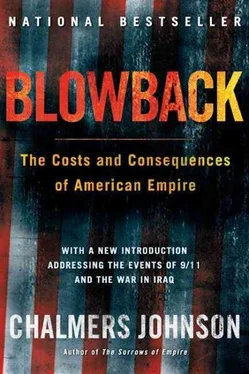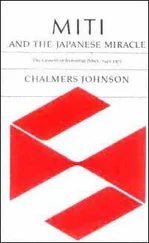Chalmers Johnson - Blowback, Second Edition - The Costs and Consequences of American Empire
Здесь есть возможность читать онлайн «Chalmers Johnson - Blowback, Second Edition - The Costs and Consequences of American Empire» весь текст электронной книги совершенно бесплатно (целиком полную версию без сокращений). В некоторых случаях можно слушать аудио, скачать через торрент в формате fb2 и присутствует краткое содержание. Год выпуска: 0101, ISBN: 0101, Издательство: Macmillan, Жанр: Старинная литература, на английском языке. Описание произведения, (предисловие) а так же отзывы посетителей доступны на портале библиотеки ЛибКат.
- Название:Blowback, Second Edition: The Costs and Consequences of American Empire
- Автор:
- Издательство:Macmillan
- Жанр:
- Год:0101
- ISBN:9780805075595
- Рейтинг книги:5 / 5. Голосов: 1
-
Избранное:Добавить в избранное
- Отзывы:
-
Ваша оценка:
- 100
- 1
- 2
- 3
- 4
- 5
Blowback, Second Edition: The Costs and Consequences of American Empire: краткое содержание, описание и аннотация
Предлагаем к чтению аннотацию, описание, краткое содержание или предисловие (зависит от того, что написал сам автор книги «Blowback, Second Edition: The Costs and Consequences of American Empire»). Если вы не нашли необходимую информацию о книге — напишите в комментариях, мы постараемся отыскать её.
Blowback, Second Edition: The Costs and Consequences of American Empire — читать онлайн бесплатно полную книгу (весь текст) целиком
Ниже представлен текст книги, разбитый по страницам. Система сохранения места последней прочитанной страницы, позволяет с удобством читать онлайн бесплатно книгу «Blowback, Second Edition: The Costs and Consequences of American Empire», без необходимости каждый раз заново искать на чём Вы остановились. Поставьте закладку, и сможете в любой момент перейти на страницу, на которой закончили чтение.
Интервал:
Закладка:
The island of Okinawa measures 454 square miles, almost exactly the size of Los Angeles and smaller than the island of Kauai in the Hawaiian chain. It now contains thirty-nine bases, ranging from Kadena Air Force Base, the largest airfield in East Asia, to the Sobe Communications Facility, known locally as the “elephant cage” because of its bizarre antennae, a center for communicating with submarines, intercepting other people’s telephone conversations, and intelligence operations. In the 1960s, when Okinawa was directly administered by the Pentagon, there were 117 bases, and at the time of the rape there were 42. Though few of them are contiguous to each other, in total they take up an estimated 20 percent of the prime agricultural land in the central and southern parts of the main island of Okinawa. The United States also controls twenty-nine areas of the surrounding seas and fifteen air spaces over the Ryukyus. As a prefecture of Japan, Okinawa occupies only 0.6 percent of Japan’s total land area, but about 75 percent of facilities exclusively used by the American armed forces stationed in Japan are concentrated there. With a population density amounting to 2,198 persons per square kilometer, it is one of the most densely populated areas in the world. Neither Japanese nor Okinawan courts or police have any jurisdiction over these American-occupied lands, seas, and air spaces.
It may be hard for Americans to imagine why a single rape case would cause such outrage among Okinawans or endanger an almost half-century-old Japanese-American security relationship. Part of the reason is because it is hard to grasp the particular imperial circumstances under which they live. A reader trying to imagine what follows would perhaps have to transpose the Okinawan situation to Greater Los Angeles, imagining the choicest fifth of it to be occupied in a similar way by an allied and “friendly” foreign military. In addition, the reader would have to understand that the very reason for the presence of those bases, weapons, and personnel, dinned into public consciousness for forty years—the enmity of an ominous neighboring superpower and its bloc of allies—had ceased to be relevant for a decade.
Certainly, from an Okinawan point of view, Admiral Macke’s remark merely confirmed what they had already long experienced: that this was not an isolated incident committed by undisciplined enlisted men but part of a pattern ignored, if not condoned, at the highest levels of the American military hierarchy. But even more important, it posed in the starkest terms a question increasingly asked in the satellites of the informal American empire: Why absorb such costs? Why, in fact, are foreign troops based in countries like Japan more than half a century after the end of World War II and more than a decade after the disappearance of the Soviet Union as a military threat?
Okinawa is the largest island in the Ryukyu chain, which is located at the southernmost tip of Japan. Its capital, Naha, is considerably closer to Shanghai than to Tokyo, and the culture of the Ryukyu Islands reflects strong Chinese as well as Japanese influences. The Ryukyus were formerly an independent kingdom, annexed by Japan in the late nineteenth century, at about the same time the United States annexed the Hawaiian Islands.
The main island of Okinawa was the scene of the last great battle of World War II—also the last time the United States used military force victoriously in East Asia. (During the Korean War, General Douglas MacArthur’s landing at Inchon was successful but led to his march north to the Yalu River, which precipitated Chinese intervention and the United States’ ultimately having to settle for a divided Korea.) Some 14,005 Americans and 234,000 Japanese soldiers and civilians were killed in that brutal, three-month-long campaign, so bloody that it became the main American rationale for the atomic bombings of Hiroshima and Nagasaki. If using atomic weapons to end the war prevented more Okinawan-type carnage in an invasion of Japan’s main islands, then, the Americans claimed, it was more than justified.
The monument the Okinawan government built to the war dead, unveiled on the fiftieth anniversary of the end of the war, is testimony to what the Okinawans call the “typhoon of steel.” On dozens of stone tablets, it lists the names of all the people on all sides killed in the battle—Japanese and American soldiers and affiliated personnel (including the journalist Ernie Pyle), Okinawan and Japanese civilians, and Korean slave laborers. The battle lasted from April to June 1945 and totally devastated the island. In September 1945, the American armed forces occupied defeated Japan, promising to bring to those emperorruled islands an American-style series of democratic reforms. Okinawa, however, was separated off from Japan and ruled by the military in a purely autocratic manner.
From 1945 to 1972, American military officers governed Okinawa as their exclusive preserve. In 1952, retention of Okinawa proved to be the price the American government extracted from Japan in return for the signing of an early peace treaty and of the Japanese-American Security Treaty, which signaled the end of the occupation of Japan’s main islands. Many Okinawans believe that Emperor Hirohito sacrificed them in 1945 in a meaningless battle meant to elicit better surrender terms from the Allies, and that Tokyo sacrificed them again in 1952 so that the rest of Japan could regain its independence and enjoy the beginnings of a return to economic prosperity. In this view, Japan felt relatively comfortable with the Japanese-American Security Treaty largely because most American military bases were consigned to a small southern island, where they and the problems that come with them could be ignored by the majority of Japanese. (There are still, it should be added, eight major American bases in Japan proper, located at Atsugi, Iwakuni, Misawa, Sagamihara, Sasebo, Yokosuka, Yokota, and Zama.)
America’s two major wars against Asian communism—in Korea and Vietnam—could not have been fought without bases on Japanese territory. Those military outposts were critical staging and logistics areas for the projection of American power onto the Asian mainland, as well as secure sanctuaries, invulnerable to attack by North Korean, Chinese, Vietnamese, or Cambodian forces. Large American staffs involved in conducting those wars lived in security and comfort, and American troops often enjoyed “R & R” (rest and recreation) in Okinawa or Japan as well as in Thailand, Hong Kong, and the Philippines. In 1965, Admiral U. S. Grant Sharp, commander in chief of American forces in the Pacific, explicitly stated that the United States could not fight the Vietnam War without its Okinawan bases.
Had the Americans had to ask for Japanese permission to conduct wars from their territory, they would have been turned down. But when the Korean War broke out in 1950, the American military still occupied all of Japan, and throughout most of the Vietnam War they still governed Okinawa as if it were their private military colony. By the late 1960s, the Americans had built their complex of more than a hundred bases, much of it by forcibly seizing land from defenseless Okinawans who were without official citizenship, legal protections, or rights of any sort from any country. When, at the height of the Vietnam War, Okinawan protests against B-52s, bars, brothels, stores of nerve gas, and G.I.-committed crimes reached a combustible point, the Americans finally took the step of officially returning Okinawa to Japanese control. Nothing, however, changed in terms of the actual American presence—except that Americans now felt obliged to justify their behavior. This they proceeded to do, ushering in a period of extraordinary American hypocrisy, mendacity, and greed, which reached an apogee just when the end of the Cold War seemed to signal a possible end to the daily indignities inflicted on the 1.3 million people of the island.
Читать дальшеИнтервал:
Закладка:
Похожие книги на «Blowback, Second Edition: The Costs and Consequences of American Empire»
Представляем Вашему вниманию похожие книги на «Blowback, Second Edition: The Costs and Consequences of American Empire» списком для выбора. Мы отобрали схожую по названию и смыслу литературу в надежде предоставить читателям больше вариантов отыскать новые, интересные, ещё непрочитанные произведения.
Обсуждение, отзывы о книге «Blowback, Second Edition: The Costs and Consequences of American Empire» и просто собственные мнения читателей. Оставьте ваши комментарии, напишите, что Вы думаете о произведении, его смысле или главных героях. Укажите что конкретно понравилось, а что нет, и почему Вы так считаете.










